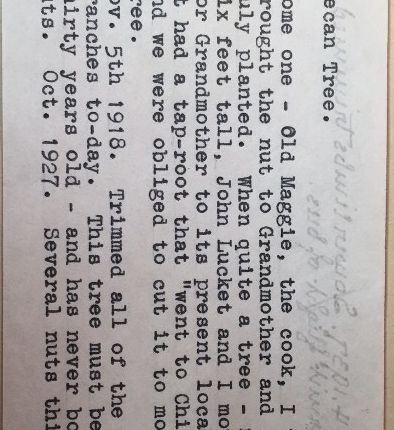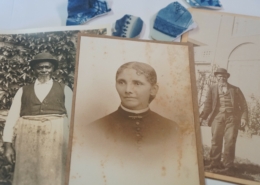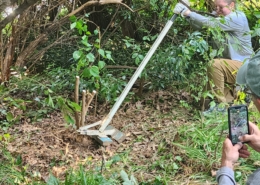From Our Garden | The Pecan Tree
By Kellie Cox, Director of Gardens and Grounds
With the season upon us for nutty treats like stuffing and candied pecans, our thoughts turn to an arboreal star at Tudor Place, its widely admired pecan tree.
In our historic gardens, we are fortunate to have a magnificent pecan tree (Carya illinoensis), Washington, D.C.’s, oldest and largest living specimen, according to the Casey Trees Living Legacy Campaign. This 80-foot-plus tree was planted from a seed nut ca. 1875, when Britannia Peter Kennon (Thomas and Martha Peter’s daughter) owned Tudor Place. Britannia planted the nut in the Dining Terrace, southwest of the historic house, from a pecan nut given to her by Maggie Carraher, an Irish immigrant who worked as the Tudor Place cook. Surprisingly, given pecans’ preference for southern climates, the tree has survived and produces fruit to this day.
The pecan tree to my left was planted during my great-grandmother’s lifetime, in the east end of the arbor, by the kitchen. I think that she had expected it to shade the path in front of the house in the afternoon, but they decided that it was a little too close to the house, and it was then moved down to where you now see it. My Father said that it stayed there for many years, practically with out growing at all, probably as a result of cutting the tap root. However, a few years later it started to grow and ever since then has made a splendid growth every year.
— Armistead Peter III
History of the Pecan Tree
The name ‘Pecan’ is a Native American term, translating to “all nuts requiring a stone to crack”. The history of pecan trees can be traced back to as early as the 1500s. Many people consider the pecan to be one of the most valuable North American nut species, as it is the only major tree nut that grows naturally in North America. One of the earliest pecan tree plantings was documented to around 1711, 60 years before the first recorded planting by colonists in the future United States. The first pecan tree planting on these shores occurred in Long Island, N.Y., in 1772. Towards the end of the 1700’s, pecan trees were planted along the eastern coast, including in the gardens of George Washington (ca. 1775) and Thomas Jefferson (ca. 1779). Their cultivation and commercial planting started in the 1880s, in Texas and Louisiana, and sales of pecans emerged throughout the country. Where Maggie Carraher obtained the nut she gave Britannia is unknown. It may have come from Mount Vernon or a local store in Washington.
Try Communications Director Mandy Katz’s recipe for candied pecans (great for homemade gift-giving!). And visit the historic pecan tree here any Tuesday through Sunday on a walk or self-guided tour of the 5½-acre historic garden for only $3 a visit. We also offer scheduled garden programs throughout the year, including monthly guided garden tours in spring through fall. Thanks for reading and stay tuned for a new From Our Garden post in December!








